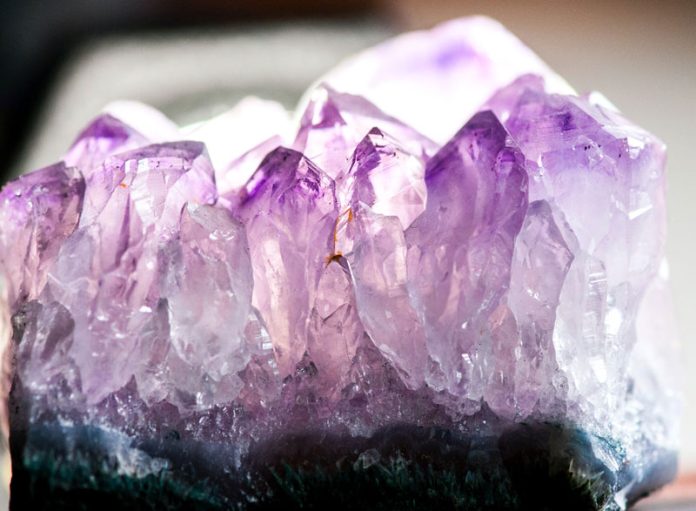
Amethyst meaning and uses are popular, and as plentiful as the amethyst crystal colors, ranging from a beautiful, rich deep purple to pale lavender and almost every shade in between. It’s ranked in the top 10 purple rocks and crystals.
Let’s first explore the legend surrounding the origin of the amethyst and then look at both historical and current uses.
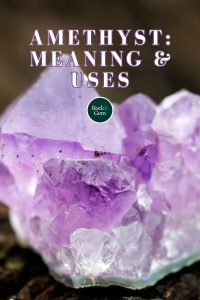
Amethyst Meaning: The Legend of Amethyste
According to legend, the wine god Bacchus sought vengeance for an insult and vowed that the next person he met would be devoured by his tigers. While on her way to worship at the shrine of the goddess Diana, a beautiful young maiden named Amethyste had the great misfortune of being that next person. True to his word, Bacchus sent his tigers after her. Diana, wanting to protect Amethyste from Bacchus’ cruelty turned the maiden into a beautiful white crystal.
Bacchus, upon seeing the stunning crystal, immediately regretted his cruelty and unfairness. As an offering he poured the grape wine from his goblet onto the white crystal, staining Amethyste a glorious purple color.
Thus, the amethyst stone was born.
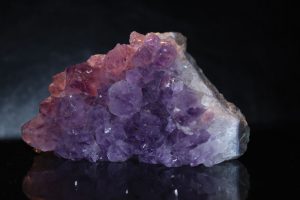
Historical Uses of Amethyst
The name “amethyst” is derived from a Greek word meaning “not intoxicated.” This legend may be the origin of the ancient belief that an amethyst stone can prevent intoxication or drunkenness. Goblets were often adorned with amethyst as it was believed that anyone who drank wine from a goblet so decorated would not become intoxicated. Catholic bishops would sometimes wear an amethyst ring to protect them from mystical intoxication. Parishioners who kissed a cleric’s amethyst ring would be similarly protected.
Amethyst meaning included the thought that it improved one’s connection to the Divine and protected against witchcraft, black magic and disease. Its curative powers were believed to include such mundane conditions as acne. Rubbing a moistened amethyst on pimples was believed to eliminate them.
The stone was purported to possess the ability to control evil thoughts, improve intelligence, and increase men’s ability to be savvy and sharp-witted in business matters.
It offered travelers protection against treachery and ambush and was also believed to aid hunters in capturing game.
Amethyst Buying TipsThere are not only different grades of amethyst, there are also fake amethysts on the market. Let’s look at some ways to tell real from fake and AA from AAAA. Color matters. One way to tell a genuine amethyst from a fake is by the color. A real stone will have color zoning with different hues. Hold the stone up to the light. If it’s a real amethyst, you should see different shades of purple beneath the surface. Generally, the deeper the color, the higher the quality. Check the clarity. To check a stone’s clarity, either shine a light on it or hold it up to the light and look for impurities. You shouldn’t see any bubbles or large areas of discoloration. Be careful, though—sometimes what appears to be an impurity may be the presence of beneficial minerals. For example, geodes with citrine quartz are thought to increase the owner’s luck in financial matters. Geode cavity depth. The depth of a geode’s cavity is believed to indicate its ability to accumulate good qi or chi (life force energy). The deeper the cavity, the greater the capacity for qi. Grades of AmethystThere are three grades of amethyst: Natural AA, Natural AAA and Natural AAAA. The lower grades of stones are the ones typically used for carvings, beads and other types of ornamental objects. Natural AA is the largest grouping and covers 50 -75% of amethyst on the market. The color for this grade is generally light to medium purple. The stones may be heavy to moderately “included.” Inclusions are crystal, gas, or liquid particles or small fractures inside the stone. Natural AAA covers approximately 20 -30% of amethyst. This grade will have fewer inclusions and will generally be darker in color than the AA. Natural AAAA is the highest grade and makes up only 10% of amethyst. Stones of this grade will be a rich dark purple and eye-clean without inclusions. The most important thing to consider when selecting a stone is your intuition. How does it feel when you hold it in your hand? You should feel drawn to it. Listen to your intuition and listen to that stone’s amethyst meaning. |
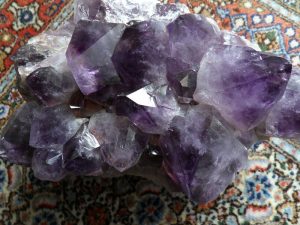
Image by rikkerst.
Amethyst Meaning: 5 Current Metaphysical Uses
Today’s uses for amethyst are as diverse as the people who use it. Included in the amethyst meaning is the belief that different shades of purple have different powers. Lighter-colored stones are thought to help with introspection or improve self-esteem and self-knowledge. The darker colors are believed to offer powerful insight, help us to see into the future, and make better decisions. Whether it’s a beautiful geode, a necklace or a polished stone, the current uses of amethyst are as varied as the historical ones. What follows are just a few of the many uses for this purple powerhouse.
1. Restful Sleep
Darker amethyst stones are sometimes referred to as dream crystals that can help us interpret our dreams and ease nightmares. Placing a small polished stone or crystal under your mattress or pillow or setting a larger stone or geode on your nightstand or under your bed may help to improve your sleep. Rubbing your forehead with a polished stone, always in a counter-clockwise direction, can help to stimulate pleasant dreams.
2. Artistic Endeavors
Amethyst meaning sometimes refers to it as an “Artist’s Stone,” “Composer’s Stone” or “Poet’s Stone.” The same properties that help connect us to the Divine and open our consciousness can help to ignite our creativity and imagination. For some, pineapple amethyst meaning is known for stimulating imagination. Placing one in your studio or workplace may improve your ability to visualize, create, and invent.
3. Feng Shui
Feng Shui is an ancient art based on the premise that all aspects of life are connected. A “bagua” is a Feng Shui map that helps you identify the different areas of your home or property, each of which is connected to a different area of your life.
Placing an amethyst stone or geode in a specific area can help to improve that area of your life. For example, clearly stating your intention and placing an amethyst wand or point in the wealth area of your home can help to attract abundance into your life.
Depending on which area in your home you place an amethyst, it can be used to attract abundance, improve your self-worth, create a stronger connection to the Divine or replace stress and negativity with peace and calm. There are five primary natural elements in Feng Shui. The amethyst is unique in its ability to balance all five.
4. Connection to Chakras
Purple is the color associated with the Crown Chakra. This chakra is the connection to spirituality and the Divine. An amethyst, especially the Chevron, is believed to help develop a person’s spiritual connection, blend the physical, mental and emotional body as well as clear the aura. Some believe it also enhances the development of our intuitive and psychic abilities.
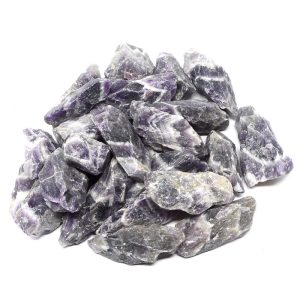
5. Meditation
Amethyst’s connection to the Crown Chakra makes it one of the best crystals for meditation. Wearing an amethyst Chevron during meditation can help quiet your mind and deepen your meditative state. An amethyst point or large clusters on a meditation altar help to calm and still your mind. When using a Single Point stone, aim the point toward you to draw energy to you and away from you to draw energy away. An amethyst wand works well as a focus talisman.
Amethyst Soul Stone
Also known as the “Soul Stone,” amethyst can also help us heal from past trauma. It can bring comfort to those with terminal illnesses.
From the mythology describing its origin to its current uses, there is one theme that runs through all amethyst’s uses— spirituality and a connection to the Divine.
If you believe in the metaphysical powers of stones, amethyst’s power can be harnessed as a piece of jewelry, a talisman to carry in your pocket, a sleep aid placed under your bed, or a focusing aid in meditation. If not, amethyst is still a beautiful stone to wear and display.
This story about amethyst meaning and uses previously appeared in Rock & Gem magazine. Click here to subscribe. Story by Kris McElhinney.















